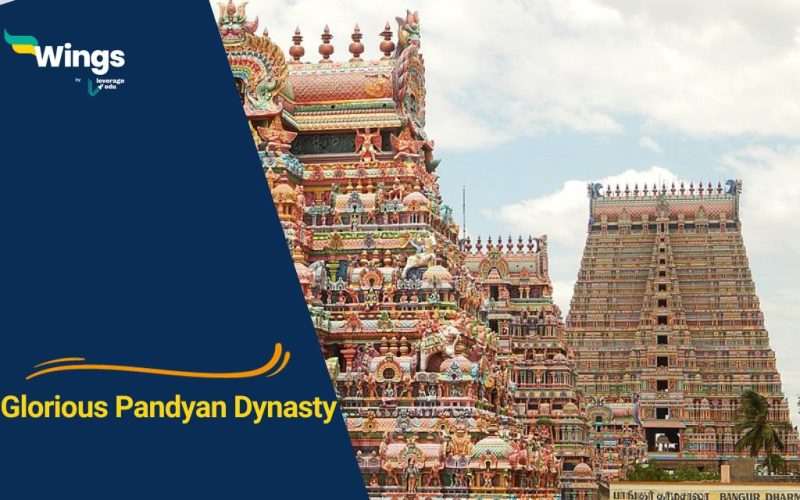The Pandyan dynasty, often known as the Pandyas of Madurai, holds a significant place in the history of South India. Dating back to the 4th to 3rd centuries BCE, this ancient Tamil dynasty ruled over extensive territories, including present-day South India and parts of northern Sri Lanka. In this blog, we delve into the intriguing history of the Pandyan dynasty, tracing its origins, achievements, and lasting impact.
Must Read: Pallava Dynasty: Origin, Achievements, and Legacy
Table of Contents
The Three Distinguished Rulers Of Tamil Nadu
The Pandyas were one of the four prominent kingdoms of Tamilakam, alongside the Pallavas, Cholas, and Cheras. These rulers were collectively referred to as the “three crowned rulers (the mu-ventar) of the Tamil country.” While the exact origins of the Pandya dynasty remain enigmatic, historical evidence suggests their existence in ancient times.
Early Days And Obscure Beginnings
In their early history, the Pandyas held sway over Pandya Nadu, which encompassed Madurai and the port city of Korkai. References to the Pandyas can be traced back to Sangam literature, dating as far back as the 4th century BCE. Supporting evidence from Graeco-Roman accounts, Ashoka’s edicts, and Tamil-Brahmi inscriptions underscores their historical presence. However, their prominence dwindled with the ascendancy of the Kalabhra dynasty in South India.
Pandya Ascendancy And Ongoing Conflicts
The Pandyas regained their dominance during the 6th to the 9th centuries CE, engaging in political rivalries with the Chalukyas of Badami, Rashtrakutas, Pallavas of Kanchi, and Cholas. They frequently expanded their rule into neighboring regions, including the fertile Kaveri estuary, Chera territory, and Sri Lanka. However, their supremacy faced challenges from the emerging Chola Empire in the 9th century, resulting in persistent conflicts.
The Golden Era Under Maravarman And Jatavarma
A renaissance of sorts occurred within the Pandyan dynasty during the 13th century CE, under the rule of leaders like Maravarman I and Jatavarman Sundara Pandya I. Jatavarman I expanded the kingdom’s boundaries into the Telugu region, southern Kerala, and northern Sri Lanka. Kanchi assumed the role of a secondary capital during this period, and the Pandyas even secured the revered Tooth Relic of the Buddha.
Internal Turmoil And Sultanate Invasions
Despite their resurgence, the Pandyan realm grappled with internal conflicts, coinciding with the Khalji invasion of South India in 1310–11. This era witnessed numerous sultanate incursions, resulting in the loss of territories like southern Kerala and northern Sri Lanka. Ultimately, the Madurai Sultanate was established in 1334, marking the conclusion of Pandyan rule.
Enduring Legacy And Contributions
The Pandyan dynasty made an indelible mark on the cultural and historical landscape of South India. They supported legendary Sangams, fostering art and literature. The architectural masterpiece, the Meenakshi Temple in Madurai, stands as a testament to their skill. It is worth noting that the Pandyas briefly embraced Jainism at one point in their history, demonstrating their religious diversity.
Exploring It’s Origin
The origin of the term “Pandya” remains a subject of debate among scholars. Some theories propose that it derives from the ancient Tamil word “pandu,” meaning “old,” while others link it to the Sanskrit word “Pandu,” signifying “white” or “pale.” Regardless of its etymological roots, the historical significance of the Pandya dynasty is undeniable.
The journey of the Pandyan dynasty across the ages is a captivating narrative of ascent, decline, and resurgence. From their mysterious beginnings to their golden age under Maravarman and Jatavarman, the Pandyas have left an enduring legacy in the annals of South Indian history. Their contributions to literature, architecture, and culture continue to be celebrated, serving as a reminder of their profound influence on Tamil Nadu and beyond
Significance
The Pandya dynasty, which ruled over the southernmost region of India, primarily in the Tamil Nadu and Kerala areas, holds significant historical and cultural importance. It thrived from ancient times through to the medieval period, contributing to the development of Dravidian culture, art, and architecture. The Pandya rulers were known for their patronage of literature and the construction of remarkable temples, including the iconic Meenakshi Amman Temple in Madurai. Their dynasty played a crucial role in trade, connecting India with the Roman Empire and Southeast Asia. The legacy of the Pandya dynasty endures through their contributions to South Indian heritage and the preservation of Tamil traditions.
Stay informed on Indian History and more with our General Knowledge section. Contact Leverage Edu for study abroad inquiries.
 One app for all your study abroad needs
One app for all your study abroad needs













